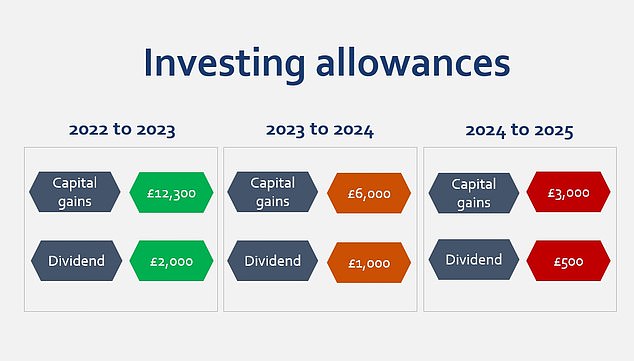Rumours of a capital gains tax raid in the budget have stepped up a gear, with claims Rachel Reeves is contemplating hiking the rate to as high as 39 per cent.
According to the Guardian, the Chancellor asked Treasury officials to model capital gains tax rates in a range of 33 to 39 per cent for the Autumn Budget, on 30 October.
This would be a massive hike to capital gains tax, which is currently charged on investment profits at 10 per cent for basic rate taxpayers and 20 per cent for higher rate taxpayers.
Capital gains tax rates of 18 per cent and 24 per cent are charged on profits from buy-to-let properties and second homes.
We explain who pays capital gains tax, why many more are due to be hit by it, how much an increase could cost people, and why experts warn a big jump in the rate might not raise as much as Reeves hopes.

Tax raid: Reports suggest that Rachel Reeves is considering hiking CGT to as high as 39%
The potential capital gains tax hike
There has been a huge amount of speculation that Chancellor Rachel Reeves will look to raise taxes on wealth in her upcoming budget, after she identified a claimed ‘£22billion black hole’ in the UK’s finances.
Labour’s manifesto ruled out increases in the rates of income tax, national insurance, VAT, which make up two thirds of tax revenue, and capped corporation tax at its current 25 per cent level.
This means that rumours have swirled for months that the Government will stage a tax raid elsewhere in the Autumn Budget, with eyes firmly locked on capital gains tax (CGT) and inheritance tax (IHT) as potential targets.
There had been some speculation that CGT could be aligned with income tax rates, pushing rates up to 20 per cent, 40 per and 45 per cent.
Experts have warned, however, that such a big jump could reduce revenue, as people put off selling investments, and should also come with the return of indexation, meaning only profts above inflation are taxed.
Now it seems that an increase in CGT is a matter of when, not if, as reports suggest Reeves has stopped short of aligning capital gains tax with income tax but has modelled hiking the rate as high as 39 per cent.
What is capital gains tax?
Capital gains tax, known as CGT, is levied on profits on assets including stocks and shares, second homes, buy-to-lets and some personal possessions.
There is an annual capital gains tax-free allowance of £3,000 and the tax is charged on profits above this.
Losses on the sale of investments can be deducted from gains on others.
Profits are defined as the difference between the price paid plus costs and the sold price. There are different rates depending on an individual’s tax bracket and the type of asset sold.
Basic rate taxpayers, those with taxable income below £50,270 pay 10 per cent CGT, while higher and additional rate taxpayers pay 20 per cent.
The rates increase for profits made on second homes and buy-to-lets, to 18 per cent for basic rate taxpayers and 24 per cent for higher and additional rate taxpayers.
The latter rate was reduced from 28 per cent in April 2024, by Conservative Chancellor Jeremy Hunt to encourage landlords to sell up to first-time buyers.
Finally, there is a separate rate for entrepreneurs selling businesses. Business Asset Disposal Relief means they pay tax at 10 per cent on all gains on qualifying assets.
Although capital gains and income tax are separate, profits are added to other income to decide the rate paid. That means that a big profit can drag a basic rate income taxpayer into the higher rate capital gains tax band.
Investments in an Isa or pension are not subject to capital gains tax.
Who pays CGT?
CGT rates are currently lower than income tax rates and profits from investments and property tend to be made by wealthier people, which makes it a prime target for a hike.
Previous figures show that around 350,000 pay capital gains tax on their profits each year, but this refers to a time when the tax-free allowance was far higher.
The number caught in the capital gains tax net is almost certain to increase substantially after Jeremy Hunt slashed the tax-free allowance from £12,300 to £3,000.
More people who hold investments outside of an Isa or pension will get caught, including small investors, those who have saved into company share schemes, pensioners using dividends to supplement income, and long-term investors from privatisations, such as British Gas.
While Starmer and Reeves have emphasised that they will not raise taxes on working people, small investors have already been heavily affected by the dramatic reduction in the CGT allowance.
Any increase in capital gains tax rates will only increase the impact of dragging more people into the tax’s net.
How much could 39% capital gains tax cost you?
The Guardian reported Reeves is considering raising capital gains tax rates to 33 and 39 per cent.
It is not clear if this is modelling different rates for basic and higher rate taxpayers or one flat rate for all.
A move to 33 to 39 per cent would be a huge hike for both basic and higher rate taxpayers.
Currently, a basic-rate taxpayer who makes a £10,000 gain on shares will pay £700 in tax, at 10 per cent of the £7,000 profit above their £3,000 tax-free allowance.
A higher rate taxpayer would pay £1,400, on the same amount but at a 20 per cent rate.
If CGT was raised to a flat 33 per cent, a £10,000 gain would incur a £2,310 bill – an increase of £1,610 for basic rate taxpayers and £910 for higher rate taxpayers
A higher rate of 39 per cent would mean handing over £2,730 to the Treasury. This would be an increase of £2,030 and £1,330 for basic and higher rate taxpayers, respectively.
If a new totally flat rate was introduced, buy-to-let landlords would face the same costs as other investors but see less of a jump in their bill, as their existing rates are higher.
Buy-to-let profits tend to be much lumpier, however, as properties need to be sold entirely meaning bigger one-off profits.
A landlord making a £100,000 gain on a buy-to-let, paying 39 per cent on the £97,000 above the annual allowance, would face a bill of £37,830 at a 39 per cent rate.
They would currently pay £23,280 at the 24 per cent CGT rate.
| Current basic rate (10%) | Current higher rate (20%) | Increased rate (33%) | Increased rate (39%) | |
|---|---|---|---|---|
| £10,000 | £700 | £1,400 | £2,310 | £2,730 |
| £20,000 | £1,700 | £3,400 | £5,610 | £6,630 |
| £30,000 | £2,700 | £5,400 | £8,910 | £10,530 |
Will Reeves introduce a high flat CGT rate?
It is unclear from reports whether Reeves is considering a flat rate of CGT, which would mean that all profits were taxed at the same level.
As we highlight above this would disproportionately penalise basic rate taxpaying investors and so would seem highly unlikely.
However, historically, the UK has had a flat rate of CGT.
Until 1988, the rate was a universal 30 per cent. Under the Conservatives, Nigel Lawson aligned it with income tax rates, but investors benefited from an ‘indexation allowance’, which meant they would only be taxed on profits above inflation.
In 2008, Gordon Brown changed the rate to flat rate of 18 per cent but removed the taper allowance that rewarded long-term investment.
Given that Starmer and Reeves have emphasised that tax rises will be for those with ‘the broadest shoulders’, it remains unclear whether the Government would introduce a flat rate or push more of the burden on to higher rate taxpayers.
The Treasury refuted the report, with a spokesman saying: ‘This reporting is not based on government modelling – we do not recognise it. This is pure speculation.’

Cut: The tax-free allowance for capital gains has been slashed in recent years
The problems with raising CGT too high
History shows that it is difficult to predict how people will react to higher rates of CGT – and that big increases in capital gains tax don’t necessarily mean a higher receipts.
If investors rushed to sell their assets ahead of a future tax rise flagged in the budget, the Treasury would see a short-term spike in receipts. But over the longer term, they may sit on their hands and avoid selling up, deterred by potential big tax bills – and perhaps in the belief that rates could be reduced again in the future.
An Institute for Fiscal Studies report ahead of the budget this week looked at previous HMRC modelling on CGT and how rises may not bring in much more tax.
It said: ‘For example, a 1 percentage point increase in the higher rates of capital gains tax in April 2025 is estimated to raise just £100 million in 2027-28 while a 10 percentage point increase is estimated to reduce revenue by around £2 billion.’
If CGT were to increase to 33 per cent, a few hundred million pounds could be raised for the Treasury, while increasing it to the middle of the range could raise about £1billion, according to reports.
If it were hiked to 39 per cent, modelling reportedly shows the annual amount of CGT could actually fall after five years.
Rachael Griffin, tax and financial planning expert at Quilter says: ‘ A full-scale reform of CGT has perhaps been deemed too lengthy a process for the Chancellor to take on, so hiking rates may be viewed as a stop gap in the hopes of boosting coffers in the nearer term.
‘However, the real question will be whether it will raise more tax – which is only likely to be in the hundreds of millions at best – or whether it would simply make people change their behaviours.
‘Unless there is a delay before implementation, increasing CGT rates would likely only incentivise people to hold assets for the long term rather than result in a quick and immediate increase in revenue.’
Wealth managers have already reported more investors are rushing to sell assets ahead of a potential capital gains tax raid.
More investors are cashing in gains to take advantage of current rates and reinvesting into tax-free wrappers. The Bed & Isa system allows investors to do this and is a service offered by many investment platforms.
A recent survey by Evelyn Partners found that nearly one in three business owners are considering a sale to avoid paying higher taxes.
Alice Haine, personal finance analyst at Bestinvest by Evelyn Partners, says: ‘Worries over a potential capital gains tax raid has also knocked investor confidence prompting many to sell assets such as second homes or shares to realise gains at a cheaper rate than if the Chancellor pushes ahead with a rumoured plan to raise CGT as high as 39 per cent.
‘Some investors are treating October 30 like the end of the tax year, with investors pouring money into tax wrappers, such as Isas and pensions to protect assets from tax.’
Some links in this article may be affiliate links. If you click on them we may earn a small commission. That helps us fund This Is Money, and keep it free to use. We do not write articles to promote products. We do not allow any commercial relationship to affect our editorial independence.












